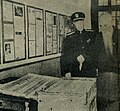You can help expand this article with text translated from the corresponding article in Chinese. (October 2021)Click [show] for important translation instructions.
|
| |||||||||||||||||||||
All 3,045 seats in the National Assembly | |||||||||||||||||||||
|---|---|---|---|---|---|---|---|---|---|---|---|---|---|---|---|---|---|---|---|---|---|
| Registered | ≈250,000,000 | ||||||||||||||||||||
| Turnout | ≈4-8% | ||||||||||||||||||||
| |||||||||||||||||||||
National Assembly elections were held between 21 and 23 November 1947 in China. They were the first elections under the newly ratified 1947 constitution. Under this constitution, the National Assembly was a constitutional convention and presidential electoral college. A total of 2,961 delegates were elected from across the country. [1]

















